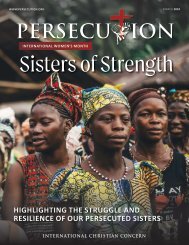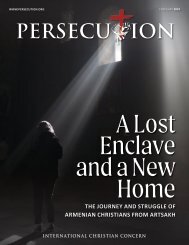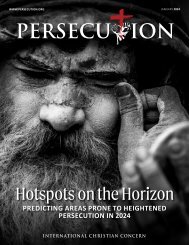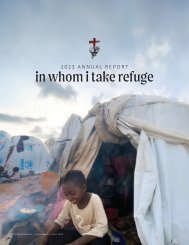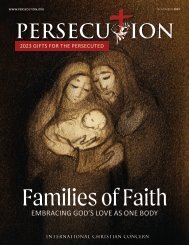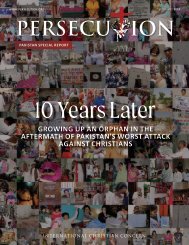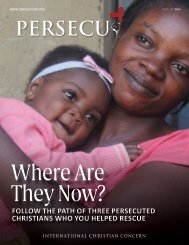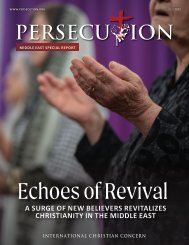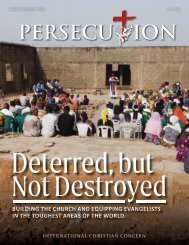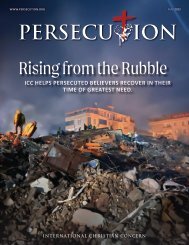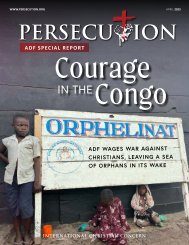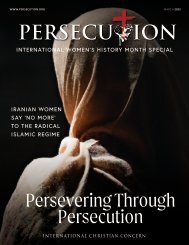October 2023 Persecution Magazine
You also want an ePaper? Increase the reach of your titles
YUMPU automatically turns print PDFs into web optimized ePapers that Google loves.
The Unseen<br />
Struggle<br />
&<br />
Injustice<br />
THAT HAUNTS A GENERATION<br />
THE UNTOLD STORIES OF PAKISTAN’S BRICK KILN WORKERS<br />
In the heart of Pakistan, where diversity is celebrated and<br />
cultural richness flows through the veins of its people, a<br />
sinister reality lies hidden, a reality that strikes at the core<br />
of humanity. Hundreds of thousands of families have endured<br />
generations of servitude within the unforgiving bounds of the<br />
brick kilns. Let us journey into the shadows of their existence,<br />
where despair and exploitation intertwine, leaving behind<br />
scars that time cannot heal.<br />
Amid the breathtaking tapestry of Pakistan’s cultural diversity<br />
and linguistic richness lies a heart-wrenching tale of suffering<br />
and struggle that often goes unnoticed. In the shadows of<br />
urban areas, where the roar of progress deafens the cries of<br />
the marginalized, the brick kiln workers of Pakistan toil in a<br />
relentless cycle of despair.<br />
Pakistan boasts a mix of of 512 ethnic groups and 74 language<br />
groups, a reflection of its vibrant soul. Amid this diversity,<br />
however, lies a dark tale of around 20,000 brick kilns that<br />
dot the landscape, predominantly congregating near urban<br />
areas. Within the blazing heart of these kilns, 4.5 million<br />
souls toil, producing a staggering 1,000 bricks each day for a<br />
mere pittance of 960 rupees. The kilns blaze at temperatures<br />
reaching a scorching 1100 degrees Celsius (2012 degrees<br />
Fahrenheit).<br />
These brick kiln laborers, often unseen and unheard, are<br />
among the most marginalized and vulnerable in Pakistan.<br />
Lacking skills and resources, they labor under dire conditions,<br />
deprived of necessities such as healthcare, education, and<br />
sanitation. Their grueling workdays, which can stretch up to<br />
12 agonizing hours, yield meager wages, sometimes as low as<br />
Rs. 700 per day. Temporary shelters, their only refuge, offer<br />
scant ventilation and expose them to the threat of fires and<br />
accidents.<br />
A CYCLE OF DEBT AND DESPAIR<br />
A seemingly innocuous loan sets in motion a cycle of bondage<br />
that clenches generations in its cruel grip. The workers,<br />
ensnared in this web of exploitation, are kept in shadows,<br />
their accounts hidden from their eyes. For these millions who<br />
suffer, hopelessness stretches before them, an unending abyss<br />
of misery.<br />
Debt spirals like a storm gathering momentum, swallowing<br />
families whole. Illnesses, inclement weather, deaths, marriages,<br />
and births—the very fabric of life—force these workers into<br />
the jaws of this insidious trap. Falling sick or bearing a child<br />
becomes an iron chain, tethering them to the kilns until debts<br />
are repaid. The borrowed sum of 500 rupees inflates to 1,000<br />
rupees on paper, guaranteeing the perpetuation of poverty.<br />
High interest loans, corrupt officials, surreptitious deductions,<br />
and doctored accounts cripple these laborers further, while<br />
their already desperate living conditions degrade even further.<br />
An agonizing helplessness blankets them as debts escalate<br />
year after year. Families torn apart, lives shattered—some<br />
surrender, paying the ultimate price of despair through suicide.<br />
18<br />
<strong>Persecution</strong> | OCTOBER <strong>2023</strong>





